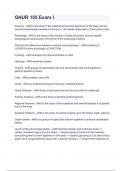GNUR 155 Exam I
Anatomy - ANS-is the study of the external and internal structures of the body and the
physical relationships between the body (i.e. the careful observation of the human body)
Physiology - ANS-is the study of the function of bodily structures, and we explain
physiological mechanisms in the terms of the underlying anatomy
What are the differences between anatomy and physiology? - ANS-Anatomy is
LOCATION while physiology is FUNCTION
Cytology - ANS-analyzes the internal structure of cells
Histology - ANS-examines tissues
Tissues - ANS-groups of specialized cells and cell products that work together to
perform specific functions
Cells - ANS-smallest units of life
Organ - ANS-an anatomical structure that has multiple functions
Gross Anatomy - ANS-Study of structures that can be seen with the naked eye
Surface Anatomy - ANS-is the study of general anatomical form
Regional Anatomy - ANS-is the study of the superficial and internal features in a specific
area of the body
Systemic Anatomy - ANS-is the study of anatomy based upon the body's organ systems
Organ system - ANS-is a group of organs that function together to produce coordinated
effects
Levels of Structural Organization - ANS-chemical (atomic and molecular level) -->
cellular (smallest living unit in the body) --> tissue (groups of cells and the materials
surrounding them to work together on one task) --> organs (grouping of 2 or more tissue
types into a recognizable structure with a specific function) --> system level collection of
,related organs with a common function, sometimes an organ is part of more than one
system) --> orgasmic level (one living individual)
Function and components of Integumentary System - ANS-protects against
environmental hazards; helps control body temperature
Skin, Hair Follicles, Sweat Glands, Nails, Sensory Receptors, Subcutaneous layer
Function and components of The Skeletal System - ANS-Supports and protects tissues;
stores minerals; forms blood cells
Bones, Cartilages, and Joints, Ligaments, Bone Marrow
Function and components of The Muscular System - ANS-Allows for locomotion
(movement and support), provides heat
Skeletal Muscles, Tendons and Aponeuroses
Function and components of The Nervous System - ANS-Directs immediate responses
to stimuli, usually by coordinating the activities of other organ systems
Central Nervous System, Peripheral Nervous Sysyem
Function and components of The Endocrine System - ANS-Directs long-term changes
in activities of other organ systems
Pineal Gland, Pituitary Gland, Thyroid Gland, Parathyroid Glands, Thymus, Adrenal
Glands, Kidneys, Pancreas, Gonads
Function and components of The Cardiovascular System - ANS-Transports cells and
dissolved materials, including nutrients, wastes, and gases
Heart, Blood Vessels, Blood
Function and components The Lymphatic System - ANS-Defends against infection and
disease; returns tissue fluid to bloodstream
Lymphatic Vessels, Lymph nodes, Spleen, Thymus
, Function and components of The Respiratory System - ANS-Delivers air to sites where
gas exchange can occur between the air and circulating blood; produces sound
Nasal Cavities and Paranasal Sinuses, Pharynx, Larynx, Trachea, Bronchi, Lungs
Function and components of The Digestive System - ANS-Processes food and absorbs
nutrients
Oral Cavity, Salivary Glands, Pharynx, Esophagus, Stomach, Small Intestine, Liver,
Gallbladder, Pancreas, Large Intestine
Function and components The Urinary System - ANS-Eliminates excess water, salts,
and wastes
Kidneys, Ureters, Urinary Bladder, Urethra
Function and components The Male Reproductive System - ANS-Produces sex cells
and hormones
Testes, Accessory Organs, External Genetalia
Function and components The Female Reproductive System - ANS-Produces sex cells
and hormones; supports embryonic and fetal development from fertilization to birth
Ovaries, Uterine Tubes, Uterus, Vagina, External Genitalia, Mammary Glands
Anatomical Position - ANS-standing with legs together, feet flat on the floor, with the
hands at the sides and palms facing forward
Supine - ANS-when lying face up
Prone - ANS-lying face down
Abdomen - ANS-abdominal
Shoulder - ANS-acromial
Antebrachium - ANS-forearm (antebrachial)




